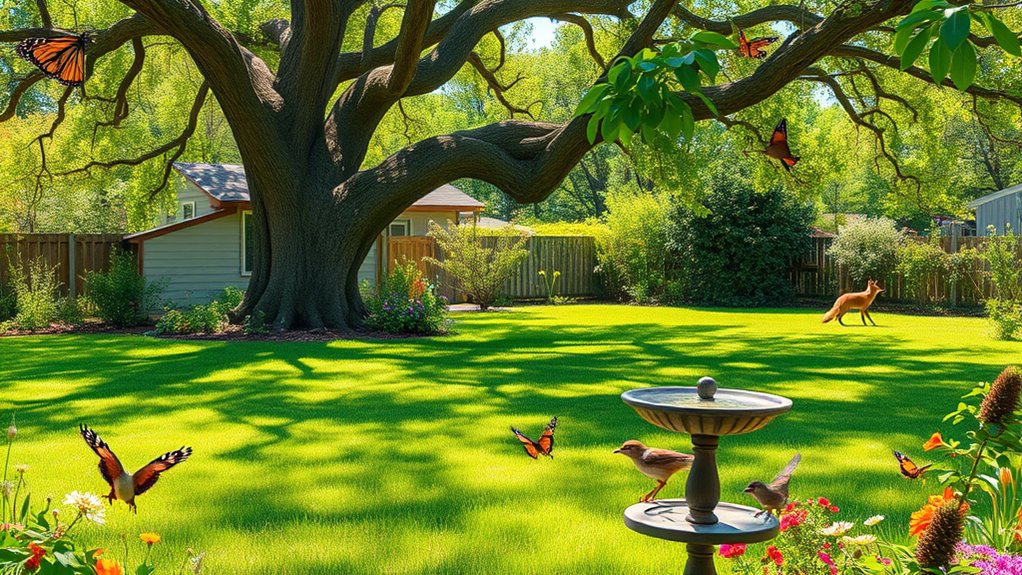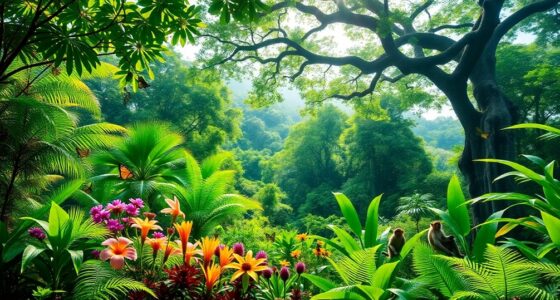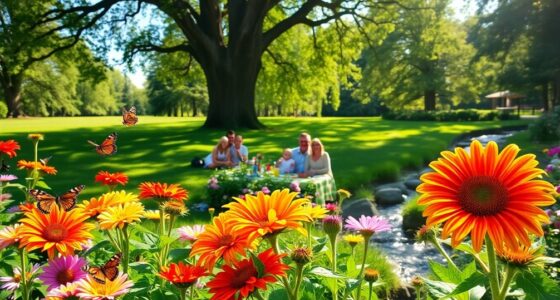In one acre, you can support a stunning variety of wildlife if you design thoughtfully. By including native plants, creating shelter options like logs and shrubs, and providing water sources, you can attract birds, pollinators, amphibians, and small mammals. Managing human activities and monitoring changes help sustain this vibrant ecosystem. With careful planning, your backyard can become a thriving mini-safari, full of life. Keep exploring to discover how to unleash your land’s full potential.
Key Takeaways
- A one-acre backyard can support diverse habitats, hosting numerous plant, bird, insect, and small animal species.
- Native plants and layered vegetation create multiple niches, boosting biodiversity and ecological resilience.
- Proper habitat design, including shelter, water sources, and food, can sustain year-round wildlife populations.
- Minimizing lawn use and chemical applications encourages healthy ecosystems supporting various life forms.
- Regular habitat management and conservation practices enhance species diversity and ecosystem health in a single acre.
Assessing Your Space: What Can a Single Acre Support?

Before transforming your backyard into a wildlife haven, it’s essential to understand what a single acre can support. Your space influences garden aesthetics and the types of wildlife it can attract. With one acre, you can create diverse habitats, but proper lawn maintenance is key to balancing open areas and natural features. Keeping your lawn well-maintained ensures it remains inviting to butterflies, birds, and small mammals while preventing invasive plants from taking over. Consider how much space you want to dedicate to native plants, shrubs, or trees, as these support different species. Evaluating your acreage helps you plan sustainable habitat zones, making the most of your land’s potential without overextending resources. Incorporating native plants into your landscape can significantly enhance the biodiversity supported by your backyard. This understanding forms the foundation for a thriving, wildlife-friendly backyard. Additionally, understanding ecosystem balance can help you create a sustainable environment that benefits both wildlife and your landscape. Maintaining healthy soil is also crucial to support the growth of native plants and promote a resilient ecosystem.
Designing a Wildlife-Friendly Landscape
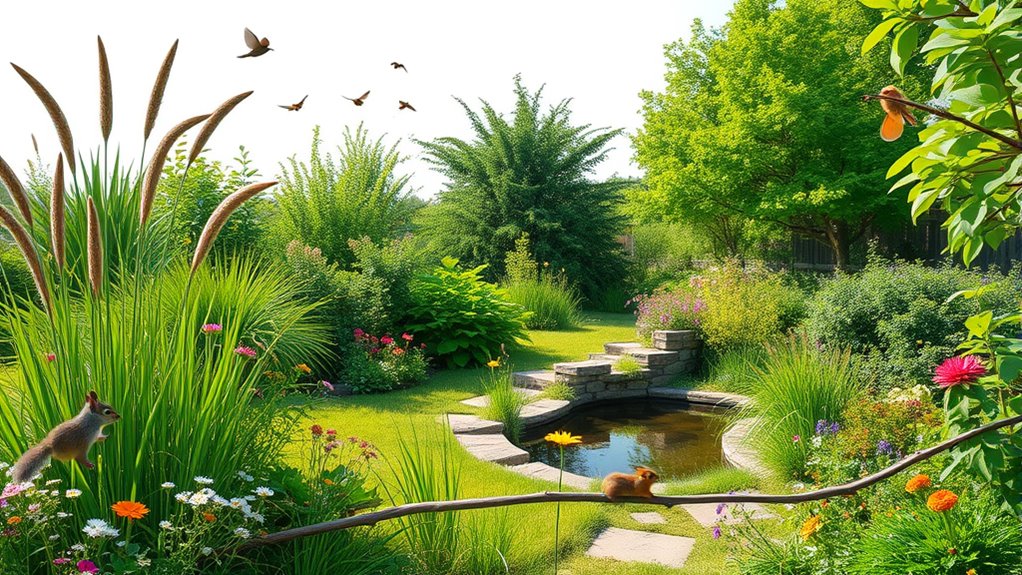
Creating a wildlife-friendly landscape involves thoughtful planning to attract and support local species. Start by choosing natural garden decor that blends seamlessly with your environment, such as logs, stone piles, or native plants. These elements provide shelter and nesting sites for birds, insects, and small mammals. Keep lawn maintenance minimal; avoid over-mowing or using chemicals that can harm wildlife. Instead, aim for a diverse landscape with native grasses and wildflower patches to offer food and habitat. Incorporate water sources like shallow ponds or birdbaths to attract more creatures. Using security cameras can help monitor and protect your wildlife habitat from potential threats. Additionally, implementing native plant selection ensures your landscape remains sustainable and beneficial for local ecosystems. To further support biodiversity, consider planting pollinator-friendly flowers that attract bees and butterflies, which are vital for healthy ecosystems. Incorporating wildlife corridors allows animals to safely move through your yard and connect with neighboring habitats. By combining thoughtful garden decor with responsible lawn care, you create an inviting space that nurtures a variety of species and transforms your yard into a lively, thriving ecosystem.
Plant Selection for Maximum Biodiversity

Choosing native plants guarantees your backyard supports local wildlife effectively. Incorporating layered vegetation creates diverse habitats that attract different species year-round. Planning for seasonal blooms keeps your landscape lively and inviting throughout all seasons. Additionally, selecting ergonomic landscaping techniques can further enhance the sustainability and health of your garden environment. Incorporating native plant diversity can also help sustain local pollinators and other beneficial insects. Implementing biodiversity benefits by planting a variety of species supports a resilient and thriving ecosystem. Using modern fixtures like water-efficient watering systems can reduce maintenance and contribute to a healthier ecosystem.
Native Plant Choices
Have you ever wondered which plants can attract the most wildlife to your backyard? Choosing native plants is key. Native plant benefits include supporting local pollinators, birds, and insects, while also aiding invasive species management. They’re adapted to your region’s soil and climate, making them resilient and low-maintenance. To maximize biodiversity, select a variety of flowering plants, shrubs, and grasses native to your area. Here’s a quick guide:
| Plant Type | Example Species | Wildlife Attracted |
|---|---|---|
| Flowering | Purple Coneflower | Bees, butterflies |
| Shrubs | Serviceberry | Birds, pollinators |
| Grasses | Little Bluestem | Birds, insects |
| Trees | Oak | Birds, mammals |
Native plants boost your backyard’s ecological health and help control invasive species. Incorporating a diverse plant selection can significantly enhance your backyard’s biodiversity and resilience. Additionally, choosing plants that are adapted to your region’s soil and climate ensures their success and sustainability over time. Selecting native plants that are recommended by local conservation organizations can also increase the likelihood of thriving in your specific environment. A well-chosen native plant palette can also create a more natural and inviting wildlife habitat, encouraging a thriving ecosystem in your own backyard. Including native plants that provide year-round cover and food sources can further support local wildlife throughout all seasons.
Layered Vegetation Structures
To attract a diverse array of wildlife, incorporating layered vegetation structures in your backyard is essential. By creating different levels of layered vegetation, you provide shelter, food, and nesting sites for various species. Use vertical planting to maximize space and add height variation, which encourages birds, insects, and small mammals to thrive. Plant shrubs and small trees as mid-layer elements, complemented by ground covers and grasses at the base. This layered vegetation mimics natural ecosystems, offering multiple niches within a single area. Mixing native plants at each level ensures food sources and habitat stability. The more diverse your layered vegetation, the more resilient and inviting your backyard becomes for wildlife. Remember, a well-structured vertical planting scheme considerably boosts biodiversity. Incorporating native plants at each layer enhances ecological stability and supports local fauna. Additionally, selecting plant species that provide seasonal resources will help sustain wildlife populations year-round. Establishing a variety of plant heights and types creates microhabitats, further increasing ecological resilience in your garden. Utilizing layered vegetation structures can also help improve soil health and reduce erosion, benefiting the overall ecosystem.
Seasonal Bloom Strategies
Incorporating plants that bloom at different times throughout the year guarantees your backyard remains a vibrant habitat for wildlife across all seasons. Seasonal bloom strategies ensure food sources like nectar, seeds, and berries are available year-round. To succeed, select a variety of native plants that flower in spring, summer, fall, and winter. Proper plant maintenance, including deadheading and pruning, encourages continuous blooming. Additionally, understanding plant diversity can inspire innovative ways to design and maintain a wildlife-friendly garden that adapts to changing conditions. Developing an understanding of pollinator relationships can further optimize your garden’s ability to support beneficial insects and birds. Here’s a sample plan:
| Spring Bloom | Summer Bloom | Fall & Winter Bloom |
|---|---|---|
| Bluebells | Black-eyed Susans | Witch Hazel |
| Tulips | Echinacea | Snowdrop |
| Forsythia | Bee Balm | Winterberry |
This diversity provides a steady food supply, supporting pollinators and birds throughout the year.
Creating Shelter and Nesting Sites

To attract wildlife, consider adding natural shelter options like hollow logs or dense shrubs. Place nesting sites thoughtfully, such as on sturdy branches or in sheltered corners of your yard. Proper placement helps animals feel safe and encourages them to settle in your outdoor space. Incorporating durable wooden toys can also provide additional stable nesting or shelter materials for some species. Additionally, providing shelter and nesting sites that mimic natural environments can significantly increase the diversity of wildlife visiting your backyard. Understanding local wildlife behavior can help you create more effective habitats to support various species. Incorporating shelter design principles can further optimize your yard for a wider variety of animals.
Natural Shelter Options
Providing natural shelter options in your backyard gives wildlife safe places to rest, hide, and raise their young. You can enhance this by creating wildlife corridors that connect different habitats, allowing animals to move safely. Incorporate bird-friendly architecture by designing structures that welcome nesting and perching. Here are some ideas:
- Leave fallen logs and brush piles to provide hiding spots.
- Plant native shrubs and trees for cover and nesting sites.
- Build or install birdhouses tailored to local species.
- Integrate natural rock formations or boulders for shelter.
- Focus on vibrational energy to attract and support healthy wildlife populations. Recognizing the importance of renewable resources can further promote a sustainable environment for your backyard ecosystem. Additionally, understanding how local climate conditions influence habitat creation can help you design more effective shelters.
These features support a diverse range of animals and encourage their movement throughout your yard. By thoughtfully designing these natural shelters, you foster a thriving, interconnected ecosystem right outside your door.
Nesting Site Placement
Since birds, small mammals, and insects rely on well-placed nesting sites, careful placement is essential to support their needs. To maximize shelter, position birdhouses away from predators and prevailing winds, ideally 5-10 feet high. Consider your yard layout when choosing nesting material choices; use natural materials like twigs, moss, and grass to encourage natural nesting behaviors. Proper birdhouses placement ensures safe, accessible nesting options, increasing occupancy rates.
| Placement Tips | Ideal Height | Materials to Use |
|---|---|---|
| Avoid predators & wind | 5-10 feet | Twigs, moss, grass |
| Shade for temperature control | Shady spots | Natural fibers |
| Near food sources | Close but safe | Soft nesting materials |
Water Sources and Their Importance

Have you ever wondered why water sources are essential for backyard wildlife? They provide hydration, support local ecosystems, and help animals stay healthy. To create a thriving habitat, consider these key points:
- Set up watering stations to give animals reliable access to fresh water.
- Build a pond through pond construction to attract amphibians, insects, and birds.
- Keep water clean and fresh, changing it regularly to prevent disease.
- Place water sources away from high-traffic areas to reduce stress for wildlife.
Attracting Birds and Insect Pollinators
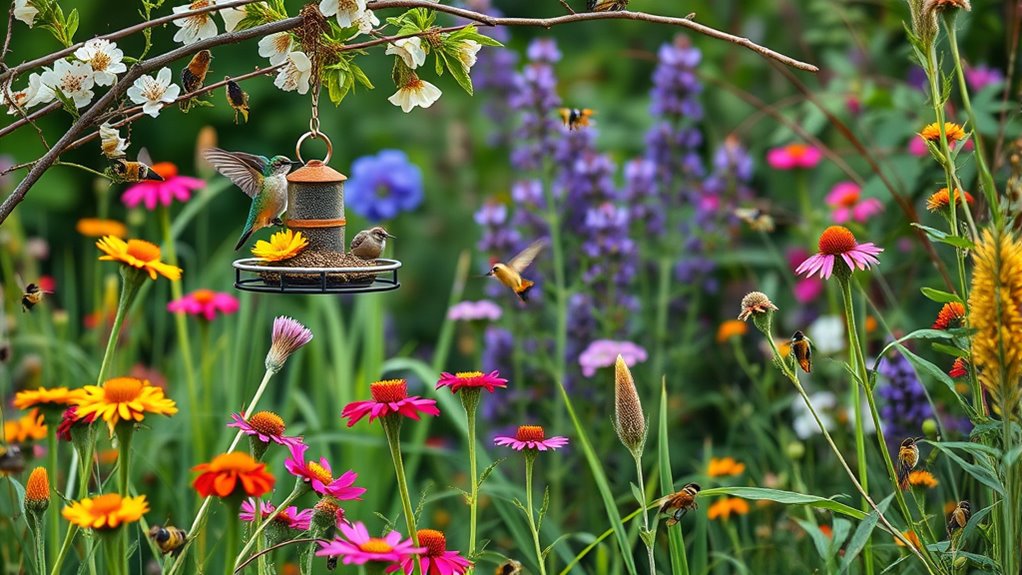
Ever wonder how to turn your backyard into a buzzing hub for birds and pollinators? Start by setting up bird feeders filled with seeds to attract a variety of songbirds. Choose feeders that are easy to refill and clean to keep visitors coming back. Incorporate insect hotels into your garden; these provide safe nesting sites for pollinators like bees and butterflies. Plant native flowering plants that bloom at different times to offer continuous nectar and pollen sources. Keep your yard pesticide-free to protect these crucial insects. By combining bird feeders, insect hotels, and native plants, you create a welcoming environment that encourages diverse wildlife. Your backyard transforms into a lively, thriving ecosystem, supporting the pollinators and birds essential for a healthy, balanced habitat.
Encouraging Amphibians and Reptiles
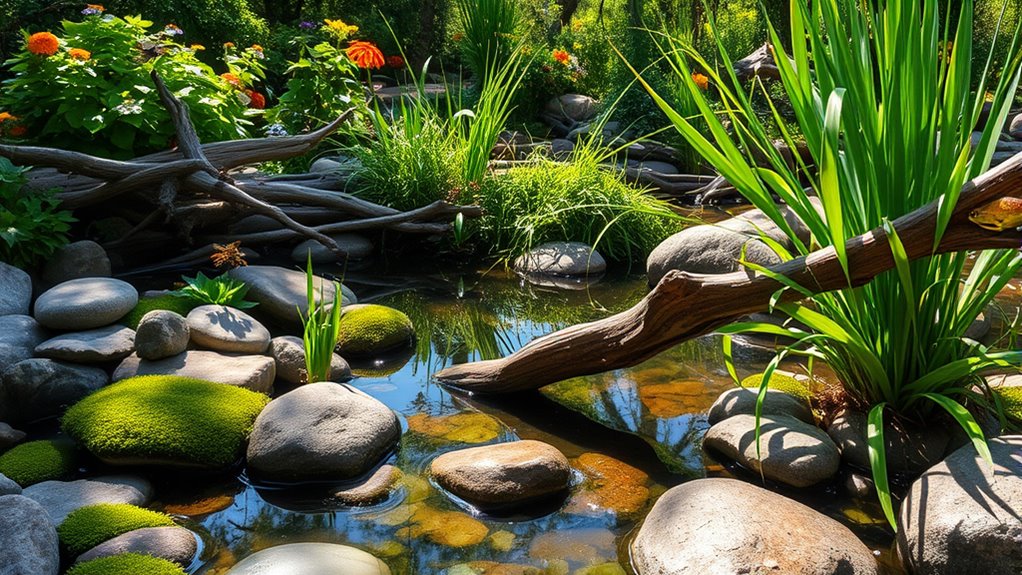
Looking to turn your backyard into a safe haven for amphibians and reptiles? You can encourage their presence with simple steps. First, create a pond or wet area to support amphibian breeding and provide essential water sources. Second, add logs, rocks, and dense shrubs to establish a diverse reptile habitat offering shelter and basking spots. Third, minimize pesticide use to keep the environment safe for all species. Fourth, leave some leaf litter and fallen branches for hiding places. These efforts help sustain healthy populations and create a balanced ecosystem. By focusing on these elements, you’ll attract frogs, salamanders, lizards, and snakes, enriching your backyard’s biodiversity and turning it into a thriving mini-wildlife sanctuary.
Managing Human Activity to Protect Wildlife
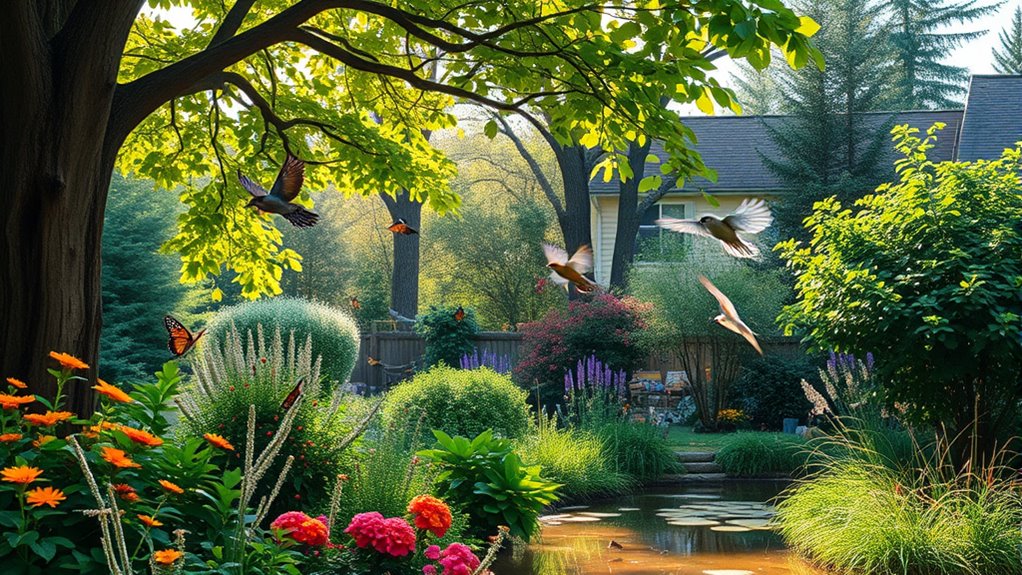
To effectively protect wildlife in your backyard, you need to manage human activity carefully. Urban expansion often encroaches on natural habitats, so limit construction or landscaping that disturbs local ecosystems. Keep traffic and foot traffic to a minimum to prevent habitat destruction and stress for animals. Be vigilant about invasive species that can outcompete native plants and animals, and remove them when possible. Avoid using pesticides and chemicals that harm wildlife; opt for natural alternatives instead. Educate family and visitors about respecting wildlife by observing from a distance and not disturbing nests or dens. By controlling these human activities, you create a safer environment for the diverse species that call your backyard home.
Monitoring and Enhancing Your Backyard Ecosystem

Monitoring your backyard ecosystem regularly allows you to understand which species thrive and identify potential issues early on. Urban noise can disturb wildlife, so observe how sound levels affect their activity and consider adding natural buffers like shrubs. To enhance your ecosystem, try these steps:
- Keep an eye on predator control, ensuring native predators balance the food chain without threatening small species.
- Use a bird feeder or water source to attract diverse birds and insects.
- Minimize disruptive human activity during active hours to reduce stress on wildlife.
- Record your observations to track changes and adapt your habitat accordingly.
Consistent monitoring helps you spot imbalances or threats, allowing you to make informed adjustments to support a thriving, balanced backyard ecosystem.
Frequently Asked Questions
How Can I Measure the Biodiversity in My Backyard Effectively?
To measure biodiversity in your backyard effectively, track bird sightings and record insect diversity regularly. Use a notebook or app to log different species you observe, noting their abundance and behaviors. Take photos to identify new visitors. Conduct surveys at various times and seasons to get a thorough picture. This approach helps you monitor changes over time and understand the richness of life thriving in your outdoor space.
What Are the Best Native Plants for Attracting Specific Wildlife Species?
If you want to attract specific wildlife, choose native plant species suited for wildlife friendly landscaping. For butterflies, plant milkweed and goldenrod; for hummingbirds, add bee balm and salvia; and for pollinators, include wildflowers like coneflowers. Many worry about planting the wrong species, but focusing on native plant selection guarantees your yard becomes a thriving habitat that supports the animals you want to see.
How Do I Balance Human Activity and Wildlife Conservation?
You can balance human activity and wildlife conservation by designing your space to minimize urban expansion impacts and promote pollution mitigation. Limit development, use eco-friendly materials, and create natural habitats that support local species. Maintain green buffers, reduce chemical use, and promote awareness. By actively managing your land with these strategies, you protect wildlife while accommodating human needs, fostering a harmonious coexistence that benefits both your community and the environment.
What Are Common Challenges in Maintaining a Sustainable Backyard Habitat?
Maintaining a sustainable backyard habitat can feel like trying to juggle flaming torches! Common challenges include balancing garden maintenance with creating a wildlife-friendly space and managing pests without harming beneficial insects. You need to choose native plants, avoid chemicals, and provide shelter. Regular upkeep is essential, but it’s worth it for the thriving ecosystem you’ll foster. Stay patient, adapt your methods, and your backyard will become a vibrant haven for wildlife.
How Can I Identify and Control Invasive Species in My Wildlife Sanctuary?
To identify invasive species, look for plants or animals that outcompete native species, often with rapid growth or unusual features. Control them through invasive species management techniques like manual removal or targeted herbicides, always ensuring you avoid harming native plants. Focus on native plant restoration to strengthen your habitat’s resilience. Regular monitoring and early intervention are key to keeping invasive species at bay and supporting a healthy, balanced backyard ecosystem.
Conclusion
Remember, your one-acre backyard isn’t just land—it’s a living mosaic waiting to thrive. By nurturing this tiny wilderness, you become a steward of nature’s grand design, proving that even small spaces hold boundless life. Like a drop in the ocean, your efforts ripple outward, inspiring others to embrace the wild within their reach. So, step outside and let your backyard be a tribute to the incredible power of one acre to sustain life.
